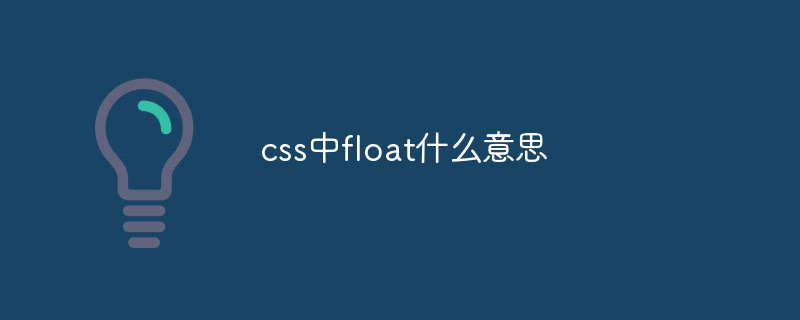Home >Common Problem >What does css float mean?
What does css float mean?
- 小老鼠Original
- 2023-10-11 17:21:281668browse
float in css is a layout attribute used to control the floating position of elements on the page. When an element is set to the float attribute, it will break away from the normal document flow and float to the left or right side of its container according to the specified direction. The float attribute can take on three values: left, right and none. left means that the element floats to the left, right means that the element floats to the right, and none means that the element does not float and returns to the normal document flow.

Operating system for this tutorial: Windows 10 system, Dell G3 computer.
float in CSS is a layout attribute used to control the floating position of elements on the page. When an element is set to the float attribute, it will break away from the normal document flow and float to the left or right side of its container according to the specified direction.
The float attribute can take on three values: left, right and none. left means that the element floats to the left, right means that the element floats to the right, and none means that the element does not float and returns to the normal document flow.
Floating elements will affect the layout of other elements in their containers. When an element is set to the float attribute, its container will be adjusted according to the position of the floating element to adapt to the position of the floating element.
The characteristic of floating elements is that they can be displayed side by side with other elements to form a multi-column layout. Floated elements automatically adjust their position to accommodate changes in page size. This makes floated elements ideal for creating responsive layouts.
The usage scenarios of floating elements are very wide. Common applications include creating multi-column layouts, implementing text wrapping effects, creating mixed graphics and text, etc.
When using floating elements, you need to pay attention to the following points:
1. Clear floats: When a container contains floating elements, the height of the container will collapse, causing the container to be unable to display normally. . To solve this problem, you can add a clearfix class at the end of the container and use the clear:both attribute to clear the floats.
2. The height of the parent element: When all child elements in a container are set to float attributes, the height of the container will collapse. To solve this problem, you can add an empty div element in the container and set the clear:both attribute to clear the float.
3. The order of floating elements: Floating elements will be floated in the order they appear in HTML. If you need to change the order of floating elements, you can use the CSS order property to adjust the order of the elements.
To sum up, the float attribute in CSS is a layout attribute that controls the floating position of elements. It floats the element to the left or right side of the container, displaying it side by side with other elements. Floating elements can be used to create multi-column layouts, implement text wrapping effects, etc. When using floating elements, you need to pay attention to clearing the float and handling the height of the parent element.
The above is the detailed content of What does css float mean?. For more information, please follow other related articles on the PHP Chinese website!

